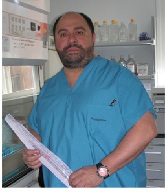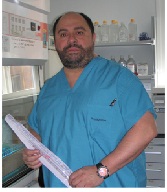Day 1 :
Keynote Forum
Simon Allen
Fine Treatment, UK
Keynote: Thermo-balancing therapy opens new opportunities in nephrology to fight effectively with chronic renal diseases
Time : 10:00-10:45

Biography:
Simon Allen obtained his PhD degree in Medicine in 1978. For over 14 years, he worked at and subsequently headed a hospital’s Cardio-Vascular Department, and treated patients with renal diseases. He has authored many scientific articles on metabolic disorders, including those linked to obesity, kidneys, arthritis, cardio-vascular and gastroenterological diseases. He lectured medical doctors pursuing higher medical qualifications. He then devoted nearly two decades to further medical research into various chronic internal diseases. He has established Fine Treatment, UK, and he is the author of The Origin of Diseases Theory and the inventor of the effective devices which enable the Thermo-balancing therapy.
Abstract:
Thermo-balancing therapy (TT) with Dr. Allen’s therapeutic device (DATD) is a unique treatment method for chronic internal diseases of different organs, including kidneys. The therapy and device were invented by Dr Simon Allen about 10 years ago, and granted a United States patent as “Therapeutic device and method” and 2 clinical investigations in the Department of Urology at Yerevan Medical University on TT with DATD in men with enlarged prostate and chronic prostatitis have shown sustainable effectiveness. It was suggested that all chronic internal diseases have the same root and start at the capillary level due to pathological capillary activity. Under certain circumstances, namely triggers, capillaries can constrict with development of focus of micro-hypothermia in the affected organs tissue. This leads to another function of capillaries spontaneous expansion in this tissue. This increases the pressure in the area, which leads to a malfunction of the organ. Continuously repeat of this pathological activity of capillaries makes a problem chronic. It should be noted, that medication, acupuncture and other treatment options unable to eliminate the focus of hypothermia, therefore surgical procedures are widely used reducing quality of life. TT with continuous effect on the focus hypothermia eliminates the pathological activity of the capillaries, stopping the progress of chronic disease. This simple solution for chronic for internal diseases should be widely investigated by nephrologists. DATD is comfortable for people and Fine Treatment Company, UK, produces and distributes it worldwide to treat various chronic conditions.
Keynote Forum
Aleksandr Vasilyev
New York Institute of Technology, USA
Keynote: Zebrafish as a model of nephron development and repair
Time : 11:00-11:45

Biography:
Aleksandr Vasilyev received his PhD from Rosalind Franklin University of Medicine and Science in 2001 and his MD degree from the same university in 2004. He then completed his Residency training in Anatimic Pathology at Massachusetts General Hospital in 2007 and a Research Fellowship in Renal Pathology in 2009. In 2009, he became an Instructor in Pathology at the Massachusetts General Hospital/Harvard Medical School, and in 2013, he started as an Assistant Professor in Biomedical Sciences at the New York Institute of Technology, College of Osteopathic Medicine. He uses zebrafish to study kidney development and regeneration.
Abstract:
Studies of mammalian kidney development and repair after injury are complicated by complex architecture of metanephric kidney and the inherent difficulty of in vivo imaging in mammals. Both of these problems are absent in embryonic and larval zebrafish which has a simple pronephric kidney that closely resembles mammalian nephron in segment identity and arrangement. By using fluorescently labeled zebrafish, we were able to show that collective cell migration lies at the center of nephron development and repair. We showed that it drives kidney segment position, shape and growth during kidney development and maturation. We were also able to show that collective migration is the primary repair mechanism after acute kidney injury. The strength of this in vivo model allows us to directly visualize the sub-cellular, cellular and organ-level interactions driving kidney development and repair. In addition, it allows an efficient and robust in vivo screening of the potential chemical modifiers of the involved cellular and molecular mechanisms. Here we report results of a chemical screen using a Lopac1280 library that strongly suggest that Src and MAPK signaling is involved in mediating collective cell migration during kidney development. We also use the novel zebrafish kidney injury model to show that kidney obstruction and not increased cell proliferation is the driving force leading to rapid cyst initiation in the zebrafish model of ADPKD. This finding sheds new light on the nature of the “third hit” suggested by inducible mouse models of ADPKD. Overall, ur findings show great potential for transgenic zebrafish as a model of kidney development, morphogenesis and pathophysiology.
Keynote Forum
Leonardo Spatola
Humanitas University, Italy
Keynote: Malnutrition and Comorbidity in chronic hemodialysis patients: a retrospective cohort studyLeonardo Spatola
Time : 11:45-12:30

Biography:
Leonardo Spatola completed his Medical Degree at University of Palermo in 2009, then Nephrology Specialization at University of Verona in 2015. He currently works as a Nephrologist in the Renal and Haemodialysis Unit at Humanitas University in Milan, Italy. He is first author of several works indexed in PubMed/Medline and he is referee for Kidney and Blood Pressure Research Journal and Saudi Journal of Kidney Disease and Transplantation.
Abstract:
Malnutrition is one of the main risk factors of mortality among Hemodialysis (HD) patients and several studies have documented that 20-60% of these patients are malnourished. Serum albumin and normalized protein catabolic rate (nPCR), are routinely used to assess nutritional status in HD patients. However, none of the currently nutritional markers has been associated to the comorbidity status in HD patients. nPCR is a measure of dietary protein intake and is calculated by using the K/DOQI formula. Due to the lack of detailed evidence, we investigated the impact of comorbidity status on nPCR values in a retrospective study involving 57 HD patients by using Charlson Comorbidity Index (CCI). Usually a Low CCI indicates a score of ≤3, while high CCI indicates a score of ≥7. In our study, we compared nPCR values of January 2015, January 2016 and January 2017 between patients with CCI<7 (group 1 n 27) and ≥7 (group 2 n 30), in order to assess if comorbidity status may affect protein catabolism. The CCI was calculated at the beginning of each year, while nPCR was obtained from a single dialysis session in the second half of January over three years. nPCR values between groups 1 and 2 across the years from 2015 to 2017 don’t show significant differences as evaluated by U-Mann Whitney test and respectively p 0.93, p 0.82 and p 0.72. Furthermore, Spearman Coefficients don’t report any correlation between the two variables: in 2015 Spearman Coefficient -0.30; p 0.82; in 2016 Spearman Coefficient – 0.08; p 0.51; in 2017 Spearman Coefficient -0.16; p 0.21. In conclusion, comorbidity status doesn’t seem to affect or to be correlated with malnutrition in HD patients.
- Nephrology | Dialysis | Hypertension and Kidney Disease | Clinical Nephrology | Pediatric Nephrology
Location: Meeting Hall : Orly

Chair
Jia L Zhuo
University of Mississippi Medical Center, USA

Co-Chair
Abelardo Aguilera
Hospital de La Princesa, Spain
Session Introduction
Jia L Zhuo
University of Mississippi Medical Center USA
Title: New insights into the roles of the Na+/H+ exchanger 3 in pressure natriuresis and angiotensin II-induced hypertension

Biography:
Jia L Zhuo is a Full Professor and the Director of Receptor and Signal Transduction Laboratory in the Department of Pharmacology and Toxicology at the University of Mississippi Medical Center, Jackson, USA. He has over 30 years of sponsored research experience on the roles of Endocrine, Paracrine, and Intracrine Angiotensin II in the kidney and hypertension, supported by National Health and Medical Research Council of Australia (NHMRC) and National Institute of Health (NIH). He has authored >110 peer-reviewed articles and book chapters with many recognized by editorials, cover highlights, and the Faculty of 1000. He is a Fellow of The American Association for The Advancement of Science (AAAS), American Heart Association (AHA), and American Society of Nephrology (ASN), a permanent member for NIH/Center for Scientific Review Hypertension and Microcirculation Study Section. His research is currently supported by grants from National Institute of Diabetes and Digestive and Kidney Diseases (NIDDK), National Institute of General Medical Sciences (NIGMS), and National Heart, Lung, and Blood Institute (NHLBI) respectively.
Abstract:
It is well established that a physiological pressure natriuretic response plays a key role in maintaining normal blood pressure and body salt and fluid balance, but the mechanisms underlying the pressure natriuresis response and its resetting to higher pressures in hypertension remain incompletely understood. Here we used wild-type (WT), global (Nhe3-/-), kidney- (tgNhe3-/-) or proximal tubule-specific knockout (PT-Nhe3-/-) of the Na+/H+ exchanger 3 (NHE3) to test the hypothesis that NHE3 in the proximal tubule of the kidney plays a critical role in the pressure natriuretic response and the development of angiotensin II (ANG II)-induced hypertension. 3 groups (n=8-12 per group) of adult male WT, Nhe3-/-, tgNhe3-/-, and PT-Nhe3-/- mice (n=8-12 per group) were prepared for the standard pressure natriuretic experiment and ANG II-induced hypertension, respectively. The pressure natriuresis response was studied using the mesenteric and celiac occlusion technique to elevate renal perfusion pressure equally by 25 mmHg in all strains of mice. Under basal conditions, Nhe3-/-, tgNhe3-/-, and PT-Nhe3-/- mice had significantly lower systolic blood pressure (p<0.01) and mean intra-arterial blood pressure than WT mice (p<0.01). 24 h fecal Na+ excretion was significantly increased (p<0.01), whereas 24 h urinary Na+ excretion was significantly reduced in both Nhe3-/- and tgNhe3-/- mice (p<0.01). However, no difference was found in fecal Na+ excretion between WT and PT-Nhe3-/- mice, whereas 24 h urinary Na+ excretion was significantly increased in PT-Nhe3-/- mice (p<0.01). In response to increased renal perfusion pressure, the pressure natriuresis response increased 4-folds in WT mice (p<0.01), and only 2-fold in Nhe3-/- and tgNhe3-/- mice (p<0.01). By comparison, the pressure natriuresis response increased 7-folds in PT-Nhe3-/- mice (p<0.01). To determine the role of NHE3 in ANG II-induced hypertension, ANG II was infused in WT, Nhe3-/-, tgNhe3-/-, and PT-Nhe3-/- mice for 2 weeks (1.5 mg/kg/day, i.p.). ANG II induced robust hypertension in WT mice (p<0.01), as expected, but the hypertensive response to ANG II was significantly attenuated in global Nhe3-/-, kidney-selective tgNhe3-/-, and PT-Nhe3-/- mice. Our results support the hypothesis that NHE3 in the proximal tubule of the kidney plays a key role in the regulation of physiological pressure natriuretic responses and the development of ANG II-induced hypertension.
Nicolas Gilles
Institute of Biology and Technology of Saclay, France
Title: Animal toxins for human health, case of the mambaquaretin for the treatment of polycystic kidney diseases

Biography:
Nicolas Gilles has completed his PhD at Paris Descartes University. He is pioneering the investigation of animal toxins acting on GPCRs, the largest therapeutic target class. His strongest expertise lies in Receptor Pharmacology, Synthetic Production of Disulfide-Linked Animal Toxins and in vivo experiments. He has published more than 70 papers and three patents. His strongest interest is now to stimulate the therapeutic development of animal toxins for the benefit of human health.
Abstract:
Autosomal dominant polykystose kidney disease affect 1 over 1,000 peoples, leading to end-stage renal disease. The blockage of the Vasopressin type 2 receptor (V2R) is a validated therapeutic line in human by preventing the vasopressin-induced elevation in intracellular cAMP concentration. Currently, only tolvaptan (jirnac) succeed to reach the market but with many concerns. Scorpions, spiders, snakes, conus, insects, miriapodes are often seen as dangerous, frightening and ugly animals. Their venoms are extremely rich in toxins historically identified for their toxicities. We believe that animal toxins are highly valuable in the context of human use and drug development. We developed a specific strategy in order to identified toxins with the purpose of discover novel drug candidates. Mambaquaretin was discovered in the green mamba venom by a bioguidage strategy directed against the V2R. This toxin belongs to the Kunitz fold peptide family, and its displays a nanomolar affinity for the V2R. Molecular pharmacological essays demonstrated that mambaquaretin is the most selective V2R antagonist. Daily injection of 13 µg of mambaquaretin to pcy mice, a model of juvenile recessive kidney polykystose, over a period of 99 days, allowed the drug candidate to inhibit cyst growth area by almost 30%. No apparent toxicity was observed in treated animals. Mambaquaretin is a promising drug candidate with an original mode of action. Molecular modelling and structure function analysis allowed us to propose a model of interaction of the mambaquaretin/V2R complex.
Stefanie Steiger
University of Munich, Germany
Title: The role of soluble uric acid and uric acid crystals in chronic kidney disease

Biography:
Stefanie Steiger has studied Bioengineering at the Martin-Luther University Halle, Germany from 2000 until 2006 followed by a working contract at Boehringer Ingelheim for two years. In 2008, she completed her PhD in Medical Science at Malaghan Institute of Medical Research, Victoria University Wellington, New Zealand, and two years of Post-doctoral fellowship. She moved to University of Munich, Germany in 2014, where she established her own group. Her research focus is the bidirectional impact of uric acid and chronic kidney disease.
Abstract:
Uric acid (UA) and chronic kidney disease (CKD) have a bidirectional relationship. The development of CKD has been associated with increased UA levels due to decreased urinary excretion of UA and resultant hyperuricemia, a major risk factor for gouty arthritis. Mild CKD often leads to an increased prevalence of gouty arthritis, as prospective observational studies have demonstrated, whereas advanced CKD and end-stage renal disease (ESRD) leads to a drop in the prevalence despite massive hyperuricemia. Conversely, there is evidence that gout and associated hyperuricemia may independently impair kidney function. Hyperuricemia in the presence or absence of gout, the use of gout medications, and the deposition of UA microcrystals in the medullary interstitium can potentially be harmful to the kidney, increase the risk for developing CKD, and are progressive factors for worsening CKD. However, these clinical data are conflicting and currently, there is no ideal animal model available to investigate the molecular effects of UA and gout in CKD in more detail, which raises the following unanswered questions: What is chicken-and-egg, CKD causes hyperuricemia but does hyperuricemia also lead to the progression of CKD? and by what mechanism? Which further raises the question: do CKD patients profit from uricostatic pharmacotherapy? What are the molecular mechanisms behind an increased prevalence of gouty arhtritis in mild CKD and a drop-in prevalence in advanced CKD? Does hyperuricemia affect UA crystal-induced inflammation by priming inflammatory cells, and is therefore responsible for the lower risk of acute gouty arthritis with advanced CKD and ESRD? These questions will be addressed in the oral presentation with supportive clinical data and an in vivo animal model.
Abelardo Aguilera
Hospital de La Princesa, Spain
Title: Tamoxifen ameliorates peritoneal membrane damage by blocking mesothelial to mesenchymal transition in peritoneal dialysis

Biography:
Mesothelial-to-mesenchymal transition (MMT) is an auto-regulated physiological process of tissue repair that in uncontrolled conditions such as peritoneal dialysis (PD) can lead to peritoneal fibrosis. The maximum expression of peritoneal fibrosis induced by PD fluids and other peritoneal processes is the encapsulating peritoneal sclerosis (EPS) for which no specific treatment exists. Tamoxifen a synthetic estrogen has successfully been used to treat retroperitoneal fibrosis and EPS associated with PD. Hence, we used in vitro and animal model approaches to evaluate the efficacy of Tamoxifen to inhibit the MMT as a trigger of peritoneal fibrosis. In vitro studies were carried out using omentum-derived mesothelial cells (MCs) and effluent-derived MCs. Tamoxifen blocked the MMT induced by transforming growth factor (TGF)-β1, as it preserved the expression of E-cadherin and reduced the expression of mesenchymal-associated molecules such as Snail, fibronectin, collagen-I, α-smooth muscle actin, and matrix metalloproteinse-2. Tamoxifen-treatment preserved the fibrinolytic capacity of MCs treated with TGF-β1 and decreased their migration capacity. Tamoxifen did not reverse the MMT of non-epitheliod MCs from effluents, but it reduced the expression of some mesenchymal molecules. In mice PD model, Tamoxifen significantly reduced peritoneal thickness, angiogenesis, invasion of the compact zone by mesenchymal MCs and improved peritoneal function. Tamoxifen also decreased the accumulation advanced glycation end-products and reduced the effluent levels of VEGF and leptin. These results demonstrate that Tamoxifen is a therapeutic option to treat peritoneal fibrosis, and that its protective effect is mediated via modulation of MMT process.
Abstract:
Mesothelial-to-mesenchymal transition (MMT) is an auto-regulated physiological process of tissue repair that in uncontrolled conditions such as peritoneal dialysis (PD) can lead to peritoneal fibrosis. The maximum expression of peritoneal fibrosis induced by PD fluids and other peritoneal processes is the encapsulating peritoneal sclerosis (EPS) for which no specific treatment exists. Tamoxifen a synthetic estrogen has successfully been used to treat retroperitoneal fibrosis and EPS associated with PD. Hence, we used in vitro and animal model approaches to evaluate the efficacy of Tamoxifen to inhibit the MMT as a trigger of peritoneal fibrosis. In vitro studies were carried out using omentum-derived mesothelial cells (MCs) and effluent-derived MCs. Tamoxifen blocked the MMT induced by transforming growth factor (TGF)-β1, as it preserved the expression of E-cadherin and reduced the expression of mesenchymal-associated molecules such as Snail, fibronectin, collagen-I, α-smooth muscle actin, and matrix metalloproteinse-2. Tamoxifen-treatment preserved the fibrinolytic capacity of MCs treated with TGF-β1 and decreased their migration capacity. Tamoxifen did not reverse the MMT of non-epitheliod MCs from effluents, but it reduced the expression of some mesenchymal molecules. In mice PD model, Tamoxifen significantly reduced peritoneal thickness, angiogenesis, invasion of the compact zone by mesenchymal MCs and improved peritoneal function. Tamoxifen also decreased the accumulation advanced glycation end-products and reduced the effluent levels of VEGF and leptin. These results demonstrate that Tamoxifen is a therapeutic option to treat peritoneal fibrosis, and that its protective effect is mediated via modulation of MMT process.
Xiao C Li
University of Mississippi Medical Center USA
Title: Inhibition of NHE3 in the proximal tubule of the kidney by an orally absorbable NHE3 inhibitor attenuates angiotensin II-induced hypertension in mice

Biography:
Xiao C Li is a Senior Research Scientist in the Receptor and Signal Transduction Laboratory in the Department of Pharmacology and Toxicology at University of Mississippi Medical Center, Jackson, Mississippi, USA. She has received Postdoctoral research training in Cardiovascular Pharmacology at Monash University, Melbourne, Australia, and in Molecular Pharmacology at University of Michigan, USA respectively. She has more than 20 years of research experience in G Protein-Coupled Receptor Pharmacology and angiotensin II-dependent hypertension, and authored more than 40 peer-reviewed articles in high impact journals such as Hypertension, Kidney International, Clinical Science, Biochemical Pharmacology, American Journal of Physiology, and Pharmacological Research etc., and a book in the renin-angiotensin system research field, and many were recognized by editorial commentaries, color cover highlights, and the faculty of 1000. Currently, she is working as a Co-Investigator in several research grants from National Institute of Diabetes and Digestive and Kidney Diseases (NIDDK), National Institute of General Medical Sciences (NIGMS), and National Heart, Lung, and Blood Institute (NHLBI).
Abstract:
We have recently shown that angiotensin (ANG II)-induced hypertension was attenuated in mice with global (Nhe3-/-) and Nhe3-/- mice with transgenic rescue of the NHE3 gene selectively in small intestines (tgNhe3-/-), suggesting a significant role of NHE3 in the development of ANG II-dependent hypertension. The present study tested whether the pharmacological inhibition of NHE3 mainly in the proximal tubule of the kidney attenuates ANG II-dependent hypertension induced by a slow pressor dose of ANG II supplemented with 2% high salt diet. 9 groups (n=6-12) of adult male C57BL/6J mice were infused with or without ANG II (500 μg/kg/day, i.p. via mini pump) and supplemented with or without a 2% NaCl diet to slowly and moderately increase blood pressure (SBP) in 2 weeks. ANG II alone increased SBP from 116±2 mmHg to 140±2 mmHg (p<0.01), and supplement of ANG II with a 2% NaCl diet further increased SBP to 147±4 mmHg (p<0.05). Concurrent treatment with an orally active, absorbable NHE3 inhibitor AVE0657 (Sanofi-Aventis; 20 mg/kg/day, p.o.) significantly decreased SBP to 125±4 mmHg in ANG II-infused mice (p<0.01), and to 134±6 mmHg in ANG II-infused mice supplemented with 2% NaCl (p<0.01), respectively. Further treatment with AVE0657 and losartan, an AT1 receptor blocker (20 mg/kg/day, p.o.), completely normalize SBP in mice treated with ANG II and 2% NaCl to control (115±5 mmHg, p<0.01). AVE0657 significantly increased 24 h urinary Na+ excretion (p<0.01) but had no effect on 24 h fecal Na+ excretion in control or ANG II-infused mice. These results provide preclinical evidence that orally absorbable NHE3 inhibitors may be pharmacologically beneficial to treat ANG II-dependent hypertension by inhibiting NHE3 and Na+ reabsorption in the proximal tubule of the kidney.
Nariaki Asada
Keio University School of Medicine Japan
Title: Polycythemia in patients born preterm with low birth weight

Biography:
Nariaki Asada graduated from Kyoto University. He researched a new testing on a diaper for urinary tract infection at pediatrics department of Ota Memorial Hospital. He is currently persuing PhD at pediatrics department of Keio University School of Medicine. Current research interests are anemia of prematurity and polycythemia in patients born preterm with low birth weight.
Abstract:
Patient 1 and 2, born at 25 weeks of gestation with birth weight of 466 g and 728 g, showed mild proteinuria at age 6 and 8 years, respectively. In association with increasing proteinuria and blood pressure (BP), polycythemia developed in adolescence. Patient 1 and 2 underwent renal biopsy at age 15 and 18 years, when their BP was 143/59 and 137/82 mmHg, eGFR 90 and 114 ml/min/m2, hemoglobin 18.7 and 19.0 g/ dL, erythropoietin (EPO) 24.5 and 17.8 U/L, respectively. Polycythemia was considered to be due to increased EPO. Light microscopy showed glomerular hypertrophy, and focal segmental glomerulosclerosis without significant fibrosis. Immunohistochemical staining with CD31 or CD34 antibody revealed PTC rarefaction.
Clinical study: Thirty-six patients with a history of extremely LBW were retrospectively analyzed (male 17, female 19; age at analysis 4-19 years; birth weight 316-998 g; gestational age 22-32 weeks). Twelve patients showed hemoglobin levels more than 2 SD above the mean (polycythemia group, male 7, female 5; age at finding 2-16 years). Polycythemia was associated with lower eGFR (73 ml/min/1.73m2 vs 106 ml/min/1.73m2) and smaller birth weight (619 g vs 802 g).
Conclusions: Polycythemia can be observed in patients born preterm with extremely low birth weight, and associated with low eGFR.
